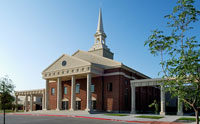By Avery Foley It comes as no surprise to anyone keeping a finger on the pulse of our culture that a dramatically high number of young people are leaving the church. …read more Read more here: AIG Daily
Eager churchgoers entering Denton Bible Church on a late summer Sunday were greeted by the toothy grins of extinct dragons. Why would a church display giant dinosaur fossils and offer an education series on these “mythical” monsters? More… …read more Read more here: icr.org
By Creation Moments Living fossils are creatures believed to be extinct and known only through the fossil record. The most famous living fossil is the Coelacanth. It is a fish, and textbooks claim it has been extinct for 70 million years according to the evolutionary timetable. Now we know that schools of them live in the Indian Ocean. read more …read more Read more here: Creation Moments
By Ken Ham We felt strongly compelled to find out what is really being taught in Christian colleges and universities today. …read more Read more here: AIG Daily
By Multimedia On this episode of ID the Future, Andrew McDiarmid narrates the prologue to Stephen Meyer’s Darwin’s Doubt: The Explosion of Animal Life and the Case for Intelligent Design. HarperOne will soon move into production on audiobook versions of Darwin’s Doubt and Signature in the Cell: DNA and the Evidence for Intelligent Design. Your browser does not support playing Audio, please upgrade your browser or find our podcast on podOmatic Download Episode …read more Read more here: id the future
By Sarah Eshleman Though the Bible never explicitly commands, “Thou shalt not commit suicide,” it talks repeatedly about life and how we can best live it. …read more Read more here: AIG Daily
By Ken Ham For years it’s been believed that humans migrated into North America and farther into South America through an ice-free corridor in British Columbia and Alberta, Canada, during the period called the Ice Age. Creationists and evolutionists have agreed that this is a likely scenario. Of course, we differ on the timing because of our different starting points. Well, this difference in timing is highlighted in new research from a team of Canadian, Danish, and American scientists. According to their new research, such a migration “would have been impossible, as there wasn’t enough food and vegetation growing in [More]
By Creation Moments For thousands of years salt has been considered valuable as a seasoning, a preservative and even as a means of payment. But could salt preserve bacteria alive for thousands or even millions of years? read more …read more Read more here: Creation Moments
By Ken Ham Recently a team of 96 people from 7 different countries gathered in Rio de Janeiro, Brazil, to share the good news of the gospel with the millions of spectators, athletes, and Brazilians at the Rio Olympics. They returned from Brazil praising the Lord for His goodness after an incredible outreach. This team handed out “wordless bracelets” and 125,000 Olympic-themed gospel booklets in 10 languages to people from 104 countries (that’s over half of the countries in the world!). Thirty-one people, that we know of, made first-time professions of faith in Christ after receiving a gospel booklet or [More]
By Simon Turpin There is an increasing number of pastors, theologians, churches, and theological institutes that use the term inerrancy, but it may well be a redefined meaning. …read more Read more here: AIG Daily
Dragon stories from all over the world are evidence that dinosaurs have been seen by humans throughout time. …read more Read more here: creation.com
By Creation Moments The lancet fluke is a parasite that accomplishes its life cycle in a most complicated, Rube Goldberg, manner. read more …read more Read more here: Creation Moments
By Ken Ham Well, what you may not know is that a creation scientist was involved in designing their bicycles! Professor Stuart Burgess is a professor of engineering design at the University of Bristol in the United Kingdom. He has an impressive resume! He’s won multiple awards for his engineering design work, holds seven patents, and even designed parts of rockets and spacecraft for the European Space Agency. And he’s a biblical creationist who has spoken for Answers in Genesis both here in America and across the UK. Secularists like Bill Nye (TV’s “The Science Guy”) often say that creationists [More]
By Ken Ham Here are some of the exciting new features of this redesign: Mobile friendly. The new website allows you to easily find content on your laptop, smartphone, or tablet (this is called “responsive design”). The content now fits your screen, regardless of its size. Our calendar feature, which lets you know what’s going on during your time at the museum, is also mobile friendly, making it easier than ever before to find events during your visit. Visually appealing. Our redesign matches the eye-catching design of ArkEncounter.com, the website for our Noah’s Ark-themed attraction, so both sites are now [More]
By Multimedia On this episode of ID the Future, Sarah Chaffee discusses the University of Chicago’s recent action to uphold academic freedom, including a letter to incoming freshman and a piece by Pres. Robert Zimmer in the Wall Street Journal. As Zimmer notes, “Every attempt to legitimize silencing creates justification for others to restrain speech that they do not like in the future.” Your browser does not support playing Audio, please upgrade your browser or find our podcast on podOmatic Download Episode …read more Read more here: id the future
By Dr. Tommy Mitchell Educators and “experts” who embrace evolution declare that children taught to reject an evolutionary worldview will never understand the world around them. …read more Read more here: AIG Daily
By Dr. Jason Lisle By embracing materialism, the atheist has destroyed the possibility of knowledge, as well as science and technology. …read more Read more here: AIG Daily
By Creation Moments I can still picture it in my mind – the large periodic table of the elements on the wall of my high school classroom. For those of you who don’t remember it, the periodic table is a tabular arrangement of all the chemical elements, ordered by their number of protons, starting with hydrogen as number one. So who invented the table? You will find his name in the table itself. Element number 101 – Mendelevium – was named after Dmitri Mendeleev, the Russian chemist who first published the periodic table in 1869. read more …read more Read [More]
By Simon Turpin Before looking at Acts 17, it is important to understand the origin of religion; in order to know the meaning of anything, we have to understand its origin. …read more Read more here: AIG Daily
How can Jesus be God if he does not know what the Father knows? …read more Read more here: creation.com
By Creation Moments Here’s an idea for those who create superhero comic books and movies. Introducing the amazing Sea Cucumber Man – able to turn his skin into a hardened shield that can stop bullets cold! read more …read more Read more here: Creation Moments
By Ken Ham The American higher education system used to be the envy of nations around the world, but in several profound ways, it is not making the grade. …read more Read more here: AIG Daily
By Ken Ham For over a century the truth behind the fake Piltdown man has remained a mystery. Many people and combinations of people have been suggested as the culprits, including Sir Arthur Conan Doyle of Sherlock Holmes fame. In a new study scientists report that evidence strongly points to a single trickster, Charles Dawson, the man who introduced the “fossil” to the scientific community. DNA recovered from the specimen shows the teeth and jaw belonged to an orangutan of the species found in Borneo, and the skull material came from two or three medieval humans. These teeth and bones [More]
A series about creationist kids at an evolutionist science camp has lessons for parents. …read more Read more here: creation.com
By Creation Moments If you had nothing better to do with your time, you might enjoy thinking about such things as: “How do I know that the whole world isn’t just a figment of someone’s imagination?” Or, “How do I know that the whole universe didn’t suddenly pop into existence 20 minutes ago?” read more …read more Read more here: Creation Moments
What’s the basis for the racist symbolism of hurling bananas at black football players? …read more Read more here: creation.com
By Creation Moments Several years ago, a Creation Moments staff member was discussing biblical creation with a well-known Bible teacher and Old Testament scholar. When this professor – whose name I will not disclose – began writing articles promoting theistic evolution for the BioLogos Foundation, he was asked to leave his teaching position at a conservative Christian seminary. read more …read more Read more here: Creation Moments





































